User Manual
This section outlines a step-by-step guide for creating multifunctional designs using the MBID ideation system,
which combines a structured design method with a visual tool.
As shown in Figure 8., users can enhance the MBID process by consulting external resources
like Ask Nature—an online database that provides curated biological strategies and their human applications.
These platforms serve as auxiliary tools, offering visual cues and biological context to support the ideation phase.
The MBID system's core is its methodical framework,
which guides users in exploring and integrating functional morphologies.
This includes a structured method that utilizes graphical mapping and representations to
support the systematic and creative generation of designs
 Fig 8: Visual representation of the MBID ideation system,
which allows users to access online sources for visual cues of structures.
Fig 8: Visual representation of the MBID ideation system,
which allows users to access online sources for visual cues of structures.
Problem-Driven and Solution-Driven Design
The MBID system supports two modes of design generation:
Problem-Driven Design: Begin with a design problem, identify required functions,
and generate a multifunctional solution.
Solution-Driven Design: Select and integrate biological
functions of interest to generate a novel multifunctional concept
Example Walkthorugh
Problem Statement
Design a multifunctional non-pneumatic
tire for space robotics or extreme-weather vehicles that: "Manages variable friction" and
"Resists impact"
Step 1: Choosing relevant Domains
The initial selection of domains for integration is driven by two key factors: the designer's
specific intention for the concept and the overarching requirements of the design problem at hand.
Step 2: Explore domain dendrograms
- Surfaces Domain
-
Match the function “manage variable friction” with a biological feature.
For example, Snakeskin texture has integrated structure i.e., triangular microstructures (scales), additional
has a structural configuration: longitudinal pits, caudal elevation, and anisotropy of microstructures.
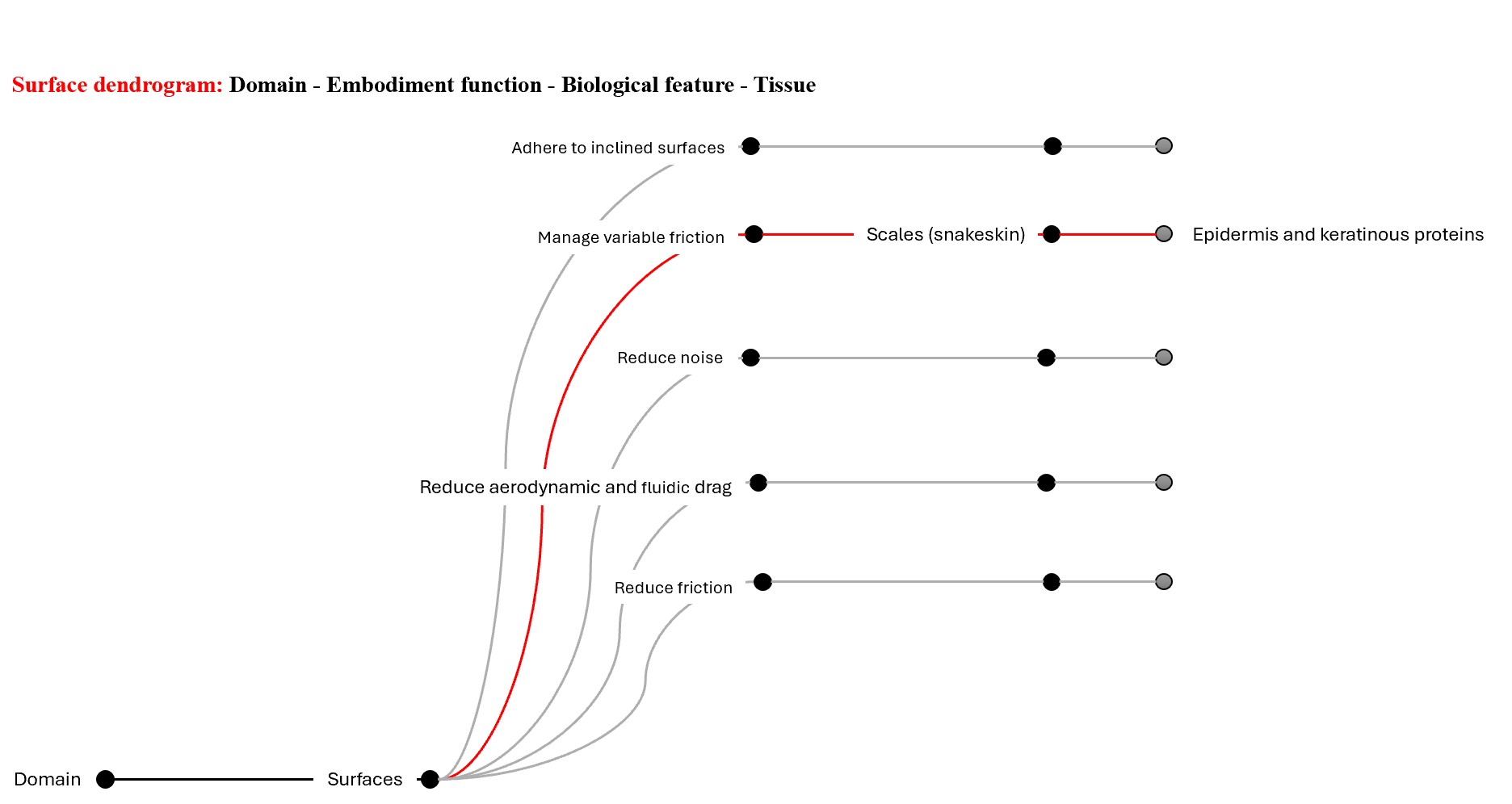
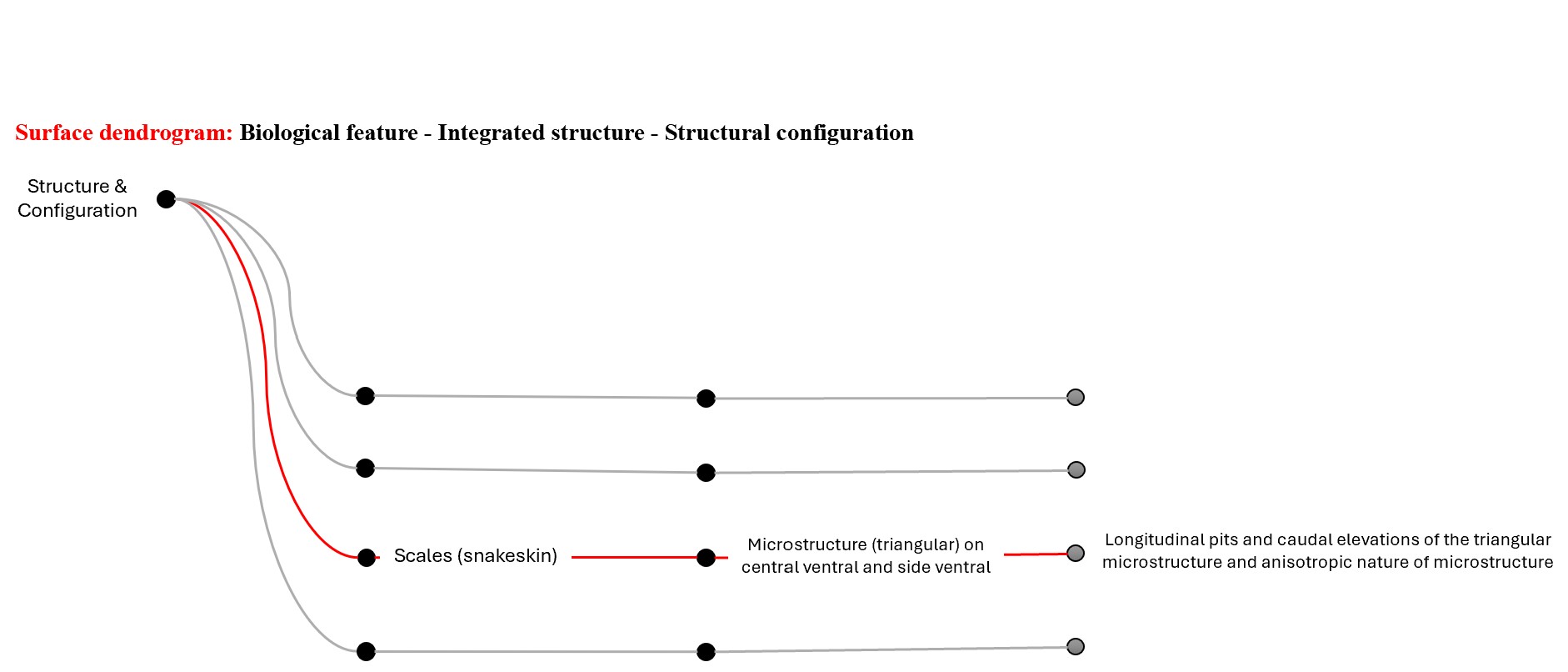
- Cellular structures Domain
-
Match the function “resist impact” with a biological feature.
For example, Woodpecker's beak has integrated structure i.e., trabecular foam core sandwiched between hard outer shells
and has a structural configuration: variable porosities—outer (30%), middle (65%), inner (30%)
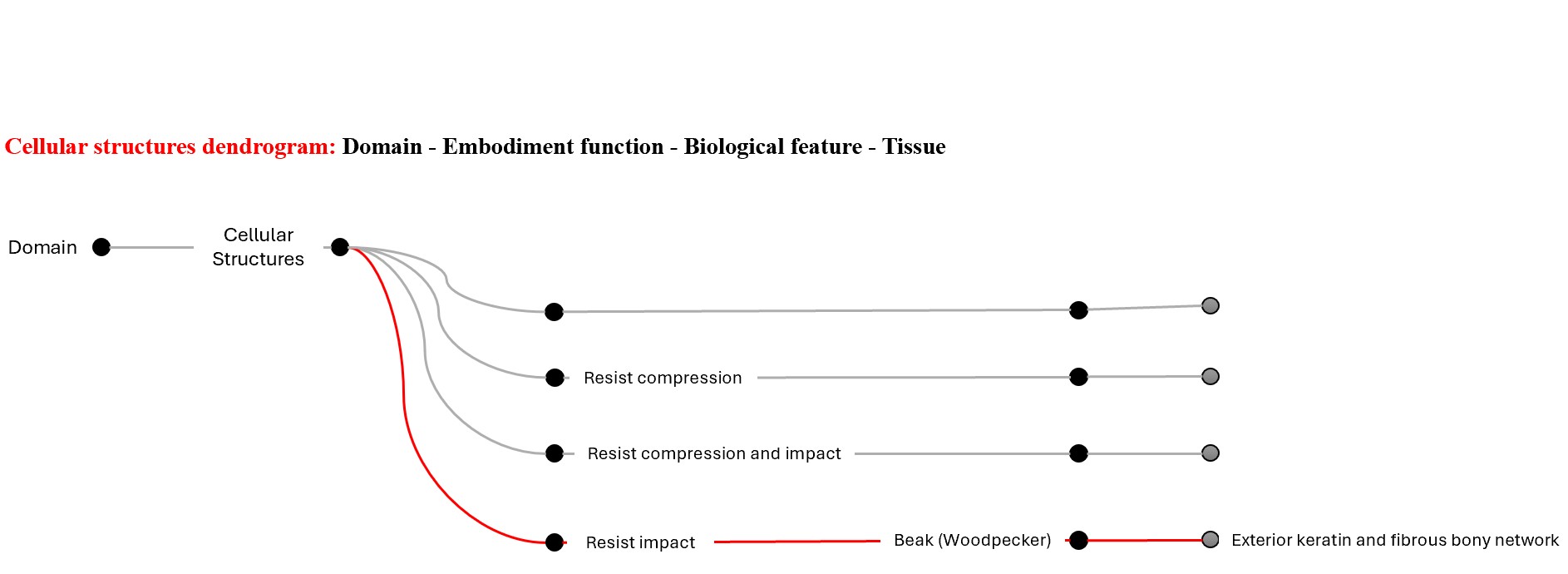
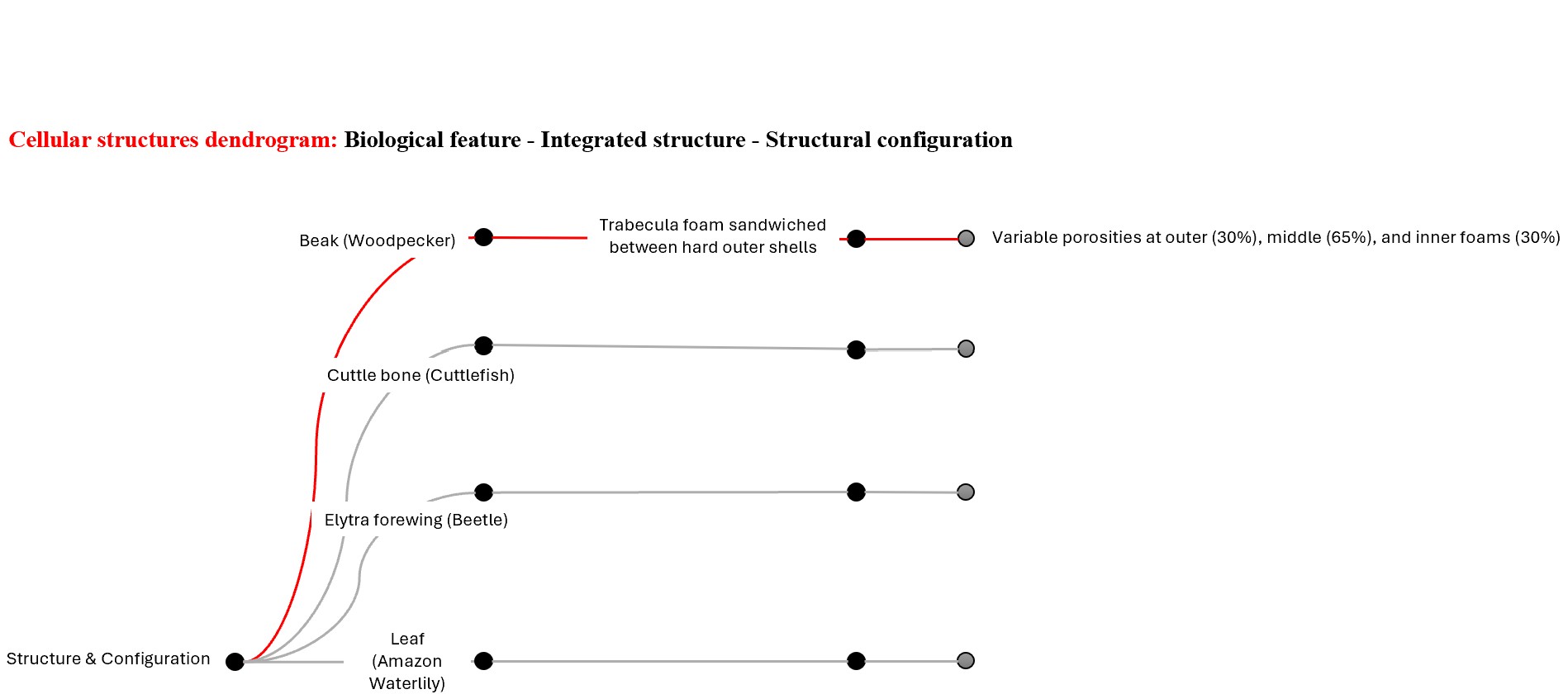
Step 3: Select features using meta-level design parameters
Multiple features may serve the same function. As shown in Figure 9, the Woodpecker's beak and the Pomelo peel exhibit
"resist impact" function and belong to the Cellular structures domain.
To choose between features that have the same geometric
characteristic (domain) and exhibit the same function, quantitative parameters
called meta-level design parameters were introduced and are listed in Table 4. To choose between alternatives, apply the design criterion:
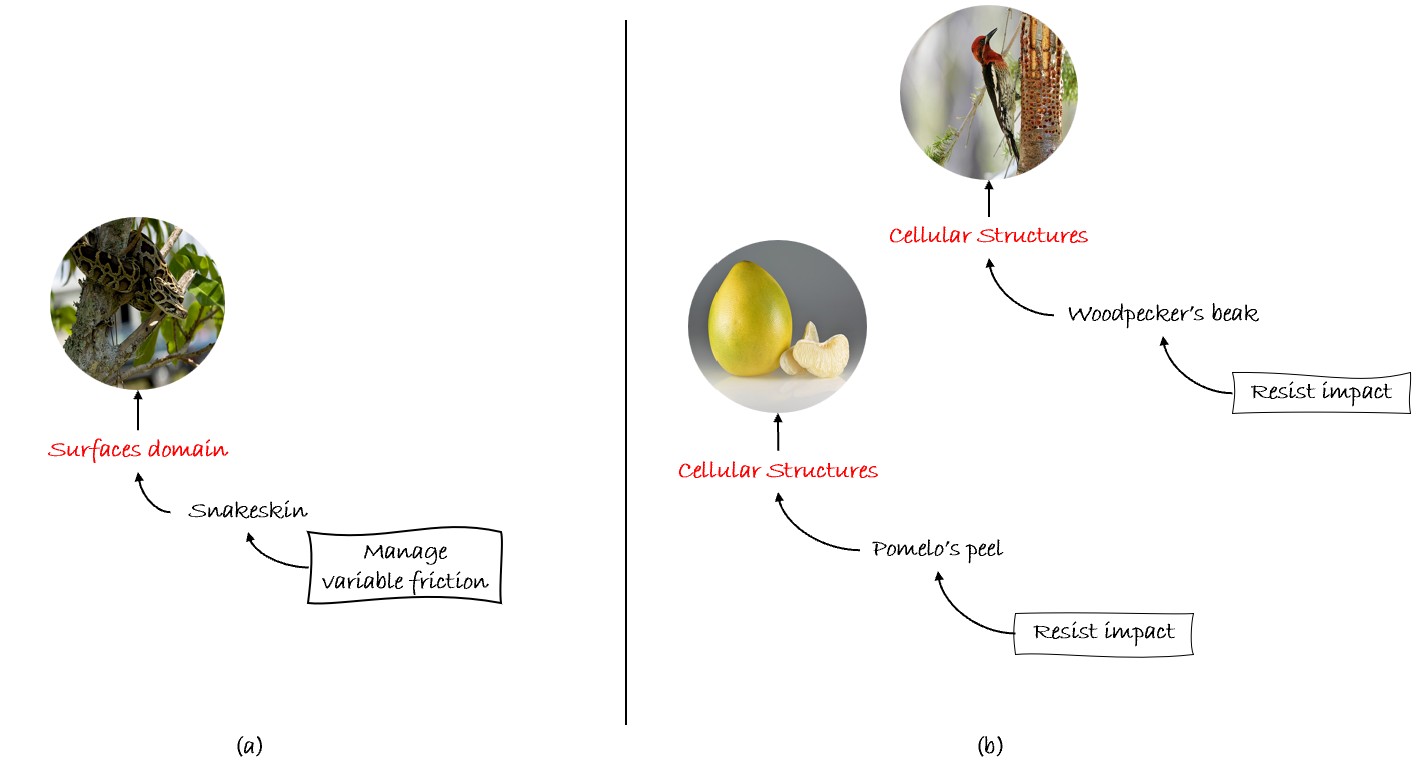 Fig 9: (a) Manage variable friction is exhibited by the snakeskin that is classified as surfaces domain.
(b) Resist impact function is exhibited by the Woodpecker beak and the Pomelo peel and are classified as cellular structures domain.
(Pictures of biological organisms from wikimedia commons)
Fig 9: (a) Manage variable friction is exhibited by the snakeskin that is classified as surfaces domain.
(b) Resist impact function is exhibited by the Woodpecker beak and the Pomelo peel and are classified as cellular structures domain.
(Pictures of biological organisms from wikimedia commons)
- Criterion 1
-
For any multifunctional application, if one of the multifunction is described as an anti-adsorption / absorption or
repulsion or reduction, select the features with a lower total interaction area for combination.
- Criterion 2
-
For any multifunctional application, if one of the multifunction can be described as
adsorption/absorption or attraction, select the features with a higher interaction area for combination.
In the case of cellular structures choose the woodpeckers beak
as it has a high interaction area and low porosity at the contact with the ground.
Note: These meta-level design parameters are just a starting point; we'll add more as the system evolves.
Qualitative parameters
Users can also incorporate additional qualitative criteria into their selections, such as the environmental context where the design will be applied.
For instance, when designing a device for arid regions, users could choose to include biological adaptations specific to those environments
Table 4: Quantative parameters for selecting relevant biological features
| Domain |
Meta-level design parameters |
| Surfaces |
Interaction area |
| Cellular Structures |
Interction area and Porosity |
| Shapes |
Scale |
| Cross-sections |
Scale |
Step 4: Combine
Use a morphology matrix to combine.The Table 5 is an example of the morphology
matrix that shows the possibilities of generating different concepts by integrating various morphologies.
Figure 10 is a visual representation of the Concept-1, integrating the snakeskin and the woodpecker's beak.
Table 5: Example morphology matrix for design of non-pneumatic multifunctional tires
| Function |
Surfaces |
Cellular structures |
Shapes |
Cross-sections |
| Manage variable friction |
Snakeskin |
-- |
Dummy organism |
-- |
| Resist impact |
-- |
woodpecker's beak |
-- |
-- |
Design Concepts:
Concept 1: Snakeskin [Surfaces domain] + Woodpecker's beak [Cellular structures domain]
Concept 2: Dummy shape [Shapes domain] + Woodpecker's beak [Cellular structures domain]
 Fig 10: Visual representation of the Concept-1 with a combination of the snakeskin and the woodpecker's
beak. (Pictures of biological organisms from wikimedia commons)
Fig 10: Visual representation of the Concept-1 with a combination of the snakeskin and the woodpecker's
beak. (Pictures of biological organisms from wikimedia commons)
Example Output: Non-pneumatic multifunctional bio-inspired tire design
The Figure 11 is a conceptual sketch of the multifunctional non-pneumatic tire design.
The design integrates the surface features of snake skin for friction management and the internal structure of a woodpecker's beak for impact resistance.
These tires are potentially suitable for use in high-terrain regions.
 Fig 11: Conceptual sketch of the multifuncitonal non-pneumatic tire generated by integrating
surface features of lotus leaf and internal core feature of woodpecker's beak.
Fig 11: Conceptual sketch of the multifuncitonal non-pneumatic tire generated by integrating
surface features of lotus leaf and internal core feature of woodpecker's beak.
Read more about the multifuncitonal bio-inspired non-pneumatic tires here:
Click link
More Embodiment-level deisgn concepts
Figure 12 presents a schematic of additional bio-inspired
engineered conceptual designs developed through the
MBID ideation system
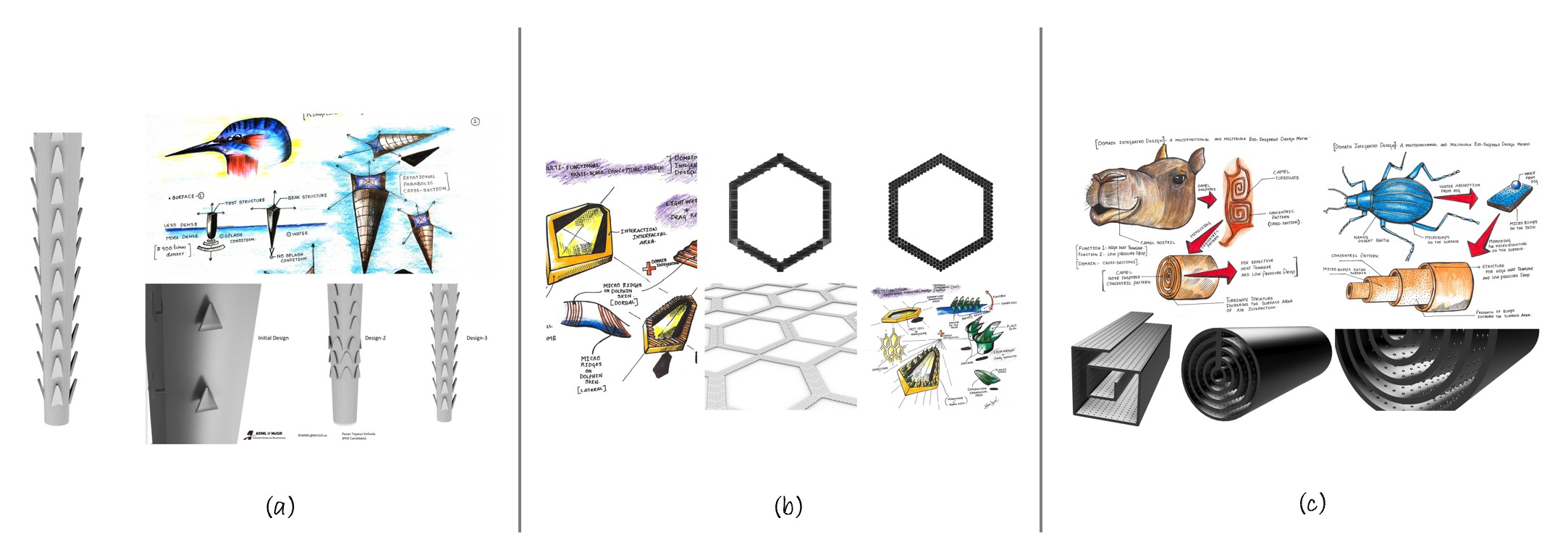 Fig 12: Conceptual designs of (a) Painless sutures for medical applications, (b) Helmets for sports applications,
(c) Heat absorption for aerospace applications and (d) Multifunctional skins for marine applications
Fig 12: Conceptual designs of (a) Painless sutures for medical applications, (b) Helmets for sports applications,
(c) Heat absorption for aerospace applications and (d) Multifunctional skins for marine applications
(a) Painless sutures for medical applications: Designed by integrating barbs on porcupine quill (surfaces)
and kingfisher's beak-rotational parabolic cross-section (cross-sections)
Click link
(b) Helmets for sports applications: Designed by integrating Penguin's spindle shape (shapes),
Luffa sponge (cellular structure), and balanus corrugated conical structure (shape)
Click link
(c) Heat absorption for aerospace applications: Designed by integrating camel nostrils (cross-sections)
and microbumbs of namib desert beetle (surfaces)
Click link
(d) Multifunctional skins for marine applications: Designed by integrating Honeycomb pattern (cellular structure)
and shark skin (surfaces)
Click link











